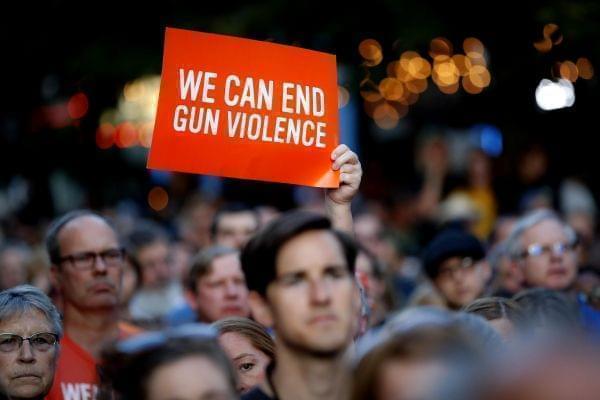As Congress Looks To Red Flag Laws, Illinois Tries To Enforce Its Own

These laws, often called extreme risk protection order laws, or red flag laws, have received renewed attention after 31 people were killed during mass shootings in El Paso, Texas, and Dayton, Ohio. John Minchillo/AP
With the public clamoring for action to reduce gun violence, Congress may soon create a federal grant program that would offer incentives for states to pass so-called “red flag” laws. Those make it easier to take firearms away from unstable people.
But even if lawmakers reach a rare bipartisan consensus and pass the bill, there’s another tough task just around the corner: Implementing it.
Illinois’ 9-month-old Firearms Restraining Order (FRO) Act offers a case study on the challenges and benefits of implementing a red flag law. The law has been used sparingly so far in Illinois, and advocates are going county by county to introduce it to law enforcement, prosecutors, and judges. Many central Illinois communities surveyed by WGLT have yet to see a single case where a FRO was obtained since Jan. 1.
There are lessons to be learned from the 16 other states (and the District of Columbia) that previously implemented red flag laws, said Mark Jones, a former ATF agent who is now senior policy advisor for the Illinois Council Against Handgun Violence (ICHV).
“What we’ve learned is that until there’s a state champion to take the law and start moving it forward and let everyone else know how the law works, it generally sits fallow,” Jones said.
For now, Illinois’ champion is ICHV.
“We’re pushing really hard to implement this across the state. We’re not waiting for the Illinois attorney general to pick up the effort, although we’ll be very, very helpful to them in doing whatever they want,” Jones said. “It’s looking very, very positive for implementation here.”
It's a public health tool. It's not a criminal tool."Mark Jones, Illinois Council Against Handgun Violence
ICHV has embarked on a statewide educational campaign about the red flag law. In May, Jones led a law enforcement training attended by 20+ agencies in Lake County in northern Illinois; a similar training is planned next for Champaign County.
Further south, ICHV Downstate Outreach Coordinator Tami Tunnell from Decatur has a tedious but important job: driving all over, county by county, stopping at each circuit clerk’s office to make sure they have the right paperwork and asking if they’ve had any cases yet.
Tunnell said she’d love to see Congress pass something to bolster red flaw laws nationally.
“I’m not gonna change (people’s) minds about whether we should have some sort of gun law. But if we have these laws, we need to be putting them into effect. We need to be making sure we’re protecting people with these laws,” Tunnell told WGLT.
Tunnell sees parallels between the red flag law and more traditional orders of protection (OPs). She started working on domestic violence prevention in 1986, and back then awareness and usage of OPs were low. Today, they’re commonplace.
“Until that really hits the ground and gets some momentum, we’re gonna be stuck with nobody really knows about it,” Tunnell said.
First Cases In Illinois
Illinois’ red flag law, signed last year by former Gov. Bruce Rauner, allows family members or police to seek an order of protection to confiscate guns for up to six months from those deemed “an immediate and present danger” to themselves or others.
It's been used 41 times since Jan. 1, with 25 orders still active, said Illinois State Police spokesperson Mindy Carroll. State Police denied a WGLT records request for additional details about each red flag case.
But anecdotes from around the state show how it's being used.
Normal Police successfully asked a judge to take away a 74-year-old man’s guns in March after officers became concerned his hallucinations could pose a public safety risk, as WGLT first reported. The man “admitted that there (was) a possibility that the medication he (was) taking (for a hip injury) is causing him to hallucinate,” officers wrote in their request for the firearm restraining order.
“His hallucinations are a serious threat of physical violence against anyone who might walk by or be lawfully present near his home and poses a clear and imminent risk of serious physical injury to himself, and other persons,” police wrote.
A judge agreed. The man’s guns were taken away until July, when the order expired on its own without a fight.
“It turned out as well as you could hope for,” Normal Police Chief Rick Bleichner said. “It worked how it was intended to work.”
Attorney Helen Ogar represented the 74-year-old man.
“He’s OK with it,” said Ogar. She said the episode “brought (the 74-year-old’s situation) to everyone’s attention” in his family.
“He’s lovely,” Ogar said. “He was just having some health issues. He went on some medications that maybe made him not as sound as he could be. We’re dealing with those as an underlying issue. And we treated it more like a social work issue than a quasi-criminal case.”
Mark Jones with ICHV praised examples like that.
“It’s a public health tool. It’s not a criminal tool,” Jones said.
Tami Tunnell with ICHV said most of the cases she’s heard about involved family members bringing their concerns to police, who then pursue the restraining order. That’s what happened in a domestic case in Monroe County near St. Louis, Tunnell said.
“It was a wife who went to law enforcement said, ‘He doesn’t hit me. He just pulls out his gun and lays it on the table and looks at me and the kids,’” Tunnell said. “She didn’t feel like she could get a (traditional) order of protection, because she felt he hadn’t done anything.”

Illinois Attorney General Kwame Raoul.
The Sangamon County sheriff’s office has used the red flag law twice, according to the county’s circuit clerk’s office. Madison County, also near St. Louis, has had a couple, Tunnell said. Wheaton and Aurora in DuPage County (near Chicago) have done at least six, said ICHV’s Mark Jones.
Other communities haven’t had any cases, including police in Bloomington, Springfield, Urbana, and Champaign County. Ditto in Woodford and Tazewell counties.
The law has already faced at least one court challenge. A Sycamore man sued the DeKalb County sheriff and Sycamore police in federal court, alleging the law violates the Second Amendment.
Illinois Attorney General Kwame Raoul intervened to defend the law, and this month a judge ordered the case dismissed, in part because no one had actually tried to use the law against the Sycamore man yet. He was claiming to be worried that someone could.
“We have already successfully defended the law against one court challenge and will continue to do so as the state’s chief legal officer,” said Annie Thompson, a spokesperson for Raoul’s office. “In addition, the Attorney General is committed to partnering with law enforcement agencies and working with residents throughout the state to help them address gun violence within their communities. Those partnerships will involve assisting agencies as they evaluate and implement the state’s new and existing firearms laws.”
There’s no target number for annual usage once everyone knows about the law, said Jones. Maryland, now fully implemented, averages around 100 per month statewide. California is in the hundreds each month, he said.
“There’s nothing for police like witnessing success,” Jones said. “One of the things we’ll be working on is to show the successful examples that have gone forward and how they’ve gone forward.”
National Movement
Though some argue red flag laws are most useful as a suicide deterrent, the mass shootings in Texas and Ohio last month are what’s driven renewed interest in the concept.
Since the mass shootings, President Trump and some congressional Republicans, including U.S. Rep. Rodney Davis from central Illinois, have signaled support for federal red flag legislation, though next steps in Congress are unclear at this point. One red flag bill with nearly 200 cosponsors, HR 1236, passed the House Judiciary Committee last week but has not been called for a full House vote. It would provide grants to help state, tribal and local efforts.
Davis, a Republican who represents parts of Bloomington-Normal, said the so-called red flag proposal is the only one with significant bipartisan backing.
“Unfortunately, folks only want to focus on the firearms side of the equation. They don’t want to focus on some other solutions that we want to put in place or some of the solutions we have,” he said.
Strong majorities of Americans from across the political spectrum support red flag laws, also known as extreme risk protection orders (ERPOs), according to a new APM Research Lab/Guns & America/Call To Mind survey. Overall, 77% of Americans surveyed support family-initiated ERPOs, and 70% support them when initiated by law enforcement, according to the survey, which was conducted before the recent Texas and Ohio shootings. There is broad support among Republicans and gun owners for these types of laws, the poll found.
NPR’s Leigh Paterson and IPR’s Mary Hansen contributed to this report.
Links
- Interfaith Vigil In Champaign-Urbana To Provide Space For Grieving, Inspire Action Against Gun Violence
- Memorial Garden In Champaign Will Honor Victims & Survivors Of Gun Violence
- Illinois AG, House Majority Leader, Vow Action Against Gun Violence
- Want To Prevent Gun Violence? Some States Turn To ‘Red Flag’ Laws

